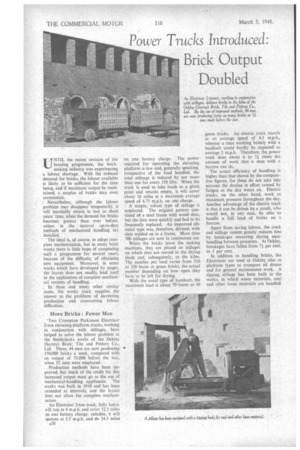Power Trucks Introduced:
Page 32

If you've noticed an error in this article please click here to report it so we can fix it.
Brick Output Doubled
UNTH_ the recent revision of the housing programme, the brickmaking industry was experiencing a labour shortage. With the reduced demand for bricks, the labour available is likely to be sufficient for the time being, and if maximum output be maintained, a surplus of bricks may even accumulate.
r Nevertheless, although the labour problem may disappear temporarily, it will inevitably return in two or three
• years' time, when the demand for bricks becomes greater than ever before, unless in the interval up-to-date methods of mechanized handling are installed.
• The ideal is, of course, to adopt complete mechanization, but in many brick works there is little hope of completing 'such a programme for several years, because of the difficulty of obtaining new equipment. Moreover, in some works which have developed by stages, the layout does not readily lend itself to the application of complete mechanical systems of handling.
In these and many other similar .cases, the works truck supplies the answer to the problems of increasing production and overcoming labour difficulties.
. More Bricks : Fewer Men
. Two Crompton Parkinson Electricar 2-ton elevating-platform trucks, working in conjunction with stillages, have helped to solve the labour problem at the SmOkejacks works of the Ockley (Surrey) Brick, Tile and Pottery Co., Ltd. There, 44 men are now producing 150,000 bricks a week, compared with an output of 75,000 before the war, when 52 men were employed.
. Production methods have been improved, but much of the credit for this increased output must go to the use of mechanical-handling appliances. The works was built in 1910 and has been extended at intervals, and the layout does not allow for complete mechanization.
An Electricar 2-ton truck, fully laden. will run at 4 m.p.h. and cover 12.5 miles on one battery charge; unladen, it will aperate at 5,5 m.p.h. and do 24.5 miles *30 on one battery charge. The power required for operating the elevating platform is low and, generally speaking. irrespective of the load handled, the total mileage is reduced by not more than one for every 150 lifts. When the truck is used to take loads to a given point and returns empty, it will cover about 16 miles at a maximum average speed of 4.75 m.p.h. on one charge.
A simple, robust type of stillage is employed. The original pattern consisted of a steel frame with wood slats, but the slats wore quickly and had to be frequently replaced. An improved allmetal type was, therefore, devised, with slats welded on to a frame. More than 700 stillages are now in continuous use.
When the bricks leave the making machines, they are placed on stillages on which they are moved to the drying sheds and, subsequently, to the kilns. The number per load varies from 310 to 350 burnt or green bricks, the actual number depending on how open they ' have to be left for drying.
With the usual type of handcart, the maximum load is about 70 burnt or 60
green bricks. An electric truck travels at an average speed of 4.5 m.p.h., whereas a man working briskly with a handcai-t could hardly be expected to average 3 m.p.h. Therefore, the power truck does about 6 to 71 times the amount of work that a man with a .barrow can do. The actual efficiency of handling is higher than that shown by the comparative figures, for these do not take into account the decline in effort caused by fatigue as the day wears on. Electric trucks, on the other hand, work at maximum pressure throughout the day. Another advantage of the electric truck is that it can be driven by a youth, who would not, in any case, be able to handle a full load of bricks on a barrow.
' Apart from saving labour, the truck and stillage system greatly reduces loss by breakages occurring during manhandling between processes. At Ockley, breakages have fallen from 7i per cent. to 1 per cent.
In addition to handling bricks, the Electricars are used at Ockley also as platform types to transport oil drums and for general maintenance work. A tipping stillage has been built in the works, in which waste materials, coat and other loose materials are handled.


















































































